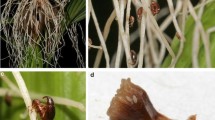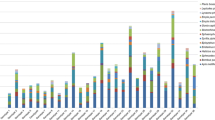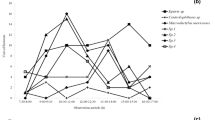Abstract
The evolution of floral scent as a plant reproductive signal is assumed to be driven by pollinator behavior, with little attention paid to other potential selective forces such as herbivores. I tested 10 out of the 13 compounds emitted by dioecious Cirsium arvense, Canada thistle, including 2-phenylethanol, methyl salicylate, p-anisaldehyde, benzaldehyde, benzyl alcohol, phenylacetaldehyde, linalool, furanoid linalool oxides (E and Z), and dimethyl salicylate. Single compounds (and one isomer) set out in scent-baited water-bowl traps trapped over 10 species of pollinators and 16 species of floral herbivores. The two dominant components of the fragrance blend of C. arvense, benzaldehyde and phenylacetaldehyde, trapped both pollinators and florivores. Other compounds attracted either pollinators or florivores. Florivores of C. arvense appear to use floral scent compounds as kairomones; by advertising to pollinators, C. arvense also attracts its own enemies.

Similar content being viewed by others
References
Adler, L. S., Karban, R., and Strauss, S. Y. 2001. Direct and indirect effects of alkaloids on plant fitness via herbivory and pollination. Ecology 82:2032–2044.
Andersson, S., Anders, N. L., Groth, I., and Bergström, G. 2002. Floral scents in butterfly-pollinated plants: Possible convergence in chemical composition. Bot. J. Linn. Soc. 140:129–153.
Baldwin, I. T., Preston, C., Euler, M., and Gorham, D. 1997. Patterns and consequences of benzyl acetone floral emissions from Nicotiana attenuata plants. J. Chem. Ecol. 23:2327–2343.
Bohlmann, J., Meyer-Gauen, G., and Croteau, R. 1998. Plant terpenoid synthases: molecular biology and phylogenetic analysis. Proc. Natl. Acad. Sci. USA 95:4126–4133.
Borrer, D. J., Triplehorn, C. A., and Johnson, N. F. 1992. An Introduction to the Study of Insects. Harcourt Brace College Publishers, New York.
Brody, A. K. 1997. Effects of pollinators, herbivores, and seed predators on flowering phenology. Ecology 78:1624–1631.
Campbell, D. R., Crawford, N., Brody, A. K., and Forbis, T. A. 2002. Resistance to pre-dispersal seed predators in a natural hybrid zone. Oecologia 131:436–443.
Cantelo, W. W. and Jacobson, M. 1979. Corn silk volatiles attract many pest species of moths. J. Environ. Sci. Health 8:695–707.
Dey, P. M. and Harborne, J. B. 1997. Plant Biochemistry. Academic Press, San Diego.
Dixon, R. A. and Paiva, N. L. 1995. Stress-induced phenylpropanoid metabolism. Plant Cell 7:1085–1097.
Dobson, H. E. M. 1994. Floral volatiles in insect biology, pp. 47–81, in E. A. Bernays (ed.). Insect Plant Interactions, vol 5. CRC Press, Boca Raton.
Dudareva, N., Martin, D., Kish, C. M., Kolosova, N., Gorenstein, N., Faldt, J., Miller, B., and Bohlmann, J. 2003. (E)-beta-ocimene and myrcene synthase genes of floral scent biosynthesis in snapdragon: function and expression of three terpene synthase genes of a new terpene synthase subfamily. Plant Cell 15:1227–1241.
Ehrlèn, J. 2002. Assessing the lifetime consequences of plant–animal interactions for the perennial herb Lathyrus vernus (Fabaceae). Perspect. Plant Ecol. Evol. Syst. 5:145–163.
Eriksson, O. 1995. Asynchronous flowering reduces seed predation in the perennial forest herb Actaea spicata. Acta Oecol.-Int. J. Ecol. 16:195–203.
Galen, C. 1983. The effects of nectar thieving ants on seedset in floral scent morphs of Polemonium viscosum. Oikos 41:245–249.
Galizia, C. G. and Menzel, R. 2001. The role of glomeruli in the neural representation of odours: results from optical recording studies. J. Insect Physiol. 47:115–130.
Haynes, K. F., Zhao, J. Z., and Latif, A. 1991. Identification of floral compounds from Abelia grandiflora that stimulate upwind flight in Cabbage looper moths. J. Chem. Ecol. 17:637–646.
Kelly, C. A. and Dyer, R. J. 2002. Demographic consequences of inflorescence-feeding insects for Liatris cylindracea, an iteroparous perennial. Oecologia 132:350–360.
Krupnick, G. A. and Weis, A. E. 1999. The effect of floral herbivory on male and female reproductive success in Isomeris arborea. Ecology 80:135–149.
Kudoh, H. and Whigham, D. F. 1998. The effect of petal size manipulation on pollinator/seed-predator mediated female reproductive success of Hibiscus moscheutos. Oecologia 117:70–79.
Lichtenthaler, H. K., Rohmer, M., and Schwender, J. 1997. Two independent biochemical pathways for isopentenyl diphosphate and isoprenoid biosynthesis in higher plants. Physiol. Plant. 101:643–652.
Louda, S. M. and Potvin, M. A. 1995. Effect of inflorescence feeding insects on the demography and lifetime fitness of a native plant. Ecology 76:229–245.
Mahoro, S. 2002. Individual flowering schedule, fruit set, and flower and seed predation in Vaccinium hirtum Thunb. (Ericaceae). Can. J. Bot.-Rev. Can. Bot. 80:82–92.
Masson, C. and Mustaparta, H. 1990. Chemical information-processing in the olfactory system of insects. Physiol. Rev. 70:199–245.
McEvoy, P. B. and Coombs, E. M. 1999. Biological control of plant invaders: regional patterns, field experiments, and structured population models. Ecol. Appl. 9:387–401.
Metcalf, R. L. 1987. Plant volatiles as insect attractants. CRC Crit. Rev. Plant Sci. 5:251–301.
Metcalf, R. L., Lampman, R. L., and Lewis, P. A. 1998. Comparative kairomonal chemical ecology of diabroticite beetles (Coleoptera: Chrysomelidae: Galerucinae: Luperini: Diabroticina) in a reconstituted tallgrass prairie ecosystem. J. Econ. Entomol. 91:881–890.
Moore, R. 1975. The biology of Canadian weeds. 13: Cirsium arvense (L) Scop. Can. J. Plant Sci. 55:1033–1048.
Mothershead, K. and Marquis, R. J. 2000. Fitness impacts of herbivory through indirect effects on plant–pollinator interactions in Oenothera macrocarpa. Ecology 81:30–40.
Nuzzo, V. 1997. Element Stewardship Abstract for Cirsium arvense. The Nature Conservancy Arlington, VA.
Ohashi, K. and Yahara, T. 2000. Effects of flower production and predispersal seed predation on reproduction in Cirsium purpuratum. Can. J. Bot.-Rev. Can. Bot. 78:230–236.
Pellmyr, O. and Thien, L. B. 1986. Insect reproduction and floral fragrances—keys to the evolution of the angiosperms. Taxon 35:76–85.
Pilson, D. 2000. Herbivory and natural selection on flowering phenology in wild sunflower, Helianthus annuus. Oecologia 122:72–82.
Plepys, D., Ibarra, F., and Lofstedt, C. 2002. Volatiles from flowers of Platanthera bifolia (Orchidaceae) attractive to the silver Y moth, Autographa gamma (Lepidoptera: Noctuidae). Oikos 99:69–74.
Proctor, M., Yeo, P., and Lack, A. 1996. The Natural History of Pollination. Timber Press, Portland.
Raguso, R. A. 2001. Floral scent, olfaction and scent-driven foraging behavior, pp. 83–105, in L. Chittka, J.D. Thomson, (eds.). Cognitive Ecology of Pollination. Cambridge University Press.
Raguso, R. A. and Pichersky, E. 1999. A day in the life of a linalool molecule: chemical communication in a plant–pollinator system. Part 1: Linalool biosynthesis in flowering plants. Plant Species Biol. 14:95–120.
Roseland, C. R., Bates, M. B., Carlson, R. B., and Oseto, C. Y. 1992. Discrimination of sunflower volatiles by the red sunflower seed weevil. Entomol. Exp. Appl. 62:99–106.
Smart, L. E. and Blight, M. M. 1997. Field discrimination of oilseed rape, Brassica napus volatiles by cabbage seed weevil, Ceutorhynchus assimilis. J. Chem. Ecol. 23:2555–2567.
Smart, L. E. and Blight, M. M. 2000. Response of the pollen beetle, Meligethes aeneus, to traps baited with volatiles from oilseed rape, Brassica napus. J. Chem. Ecol. 26:1051–1064.
Sokal, R. S. and Rohlf, F. J. 1995. Biometry. Freeman and Co., New York.
Strauss, S. Y. 1997. Floral characters link herbivores, pollinators, and plant fitness. Ecology 78:1640–1645.
Theis, N. 2003. Targeting pollinators and evading herbivores: Floral scent emission in two species of Cirsium. PhD dissertation. State University of New York at Stony Brook, Stony Brook.
Theis, N. and Raguso, R. A. 2005. The effect of pollination on floral fragrance in thistles. J. Chem. Ecol. 31:2581–2600.
Tingle, F. C. and Mitchell, E. R. 1992. Attraction of Heliothis virescens (F) (Lepidoptera, Noctuidae) to volatiles from extracts of cotton flowers. J. Chem. Ecol. 18:907–914.
Wiesenborn, W. D. and Baker, T. C. 1990. Upwind flight to cotton flowers by Pectinophora gossypiella (Lepidoptera, Gelechiidae). Environ. Entomol. 19:490–493.
Acknowledgments
I thank Robert Raguso and Manuel Lerdau for discussion and comments; Laurel Reid, Eileen Rios, and Sarah Brice for help with data collection; Karen Goodell for help with bee identification; Robin Clery from Quest International for samples of dimethyl salicylate; and two anonymous reviewers for helpful comments. This work was supported in part by Sigma Xi Grants-in-Aid of Research, American Museum of Natural History Theodore Roosevelt Memorial Fund, U.S. Department of Education GAANN Fellowship, Sokal Travel Award, The Explorers Club Exploration Fund, and a Doctoral Dissertation Improvement Grant from the National Science Foundation (DEB# 0206300).
Author information
Authors and Affiliations
Corresponding author
Rights and permissions
About this article
Cite this article
Theis, N. Fragrance of Canada Thistle (Cirsium arvense) Attracts Both Floral Herbivores and Pollinators. J Chem Ecol 32, 917–927 (2006). https://doi.org/10.1007/s10886-006-9051-x
Received:
Revised:
Accepted:
Published:
Issue Date:
DOI: https://doi.org/10.1007/s10886-006-9051-x




